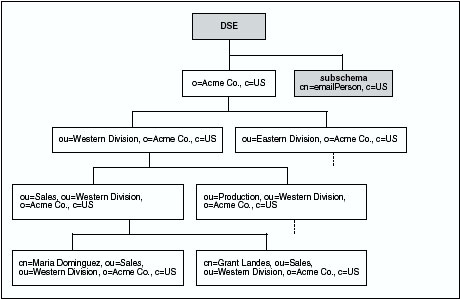Tree directory
| |
A directory may be organized in a tree structure, representing the divisions, departments, and people in an organization. Advantages over flat: The tree directory allows two people to have the same full name, department listings can be created, it's a more organized way to manage a large directory. To illustrate, here is an example for a company, using a naming context of c=US.
At the top, the company itself has an entry. Instead of a common name, it has an organization name. Its distinguished name is o=Acme Co., c=US. Its entry type is organization.

Outline of a tree-structured directory. The naming context is c=US. The two shaded entries are required and automatically created in each new datafile (see Special Entries).
The company has two divisions. These are represented by child entries whose parent is the company entry. Their distinguished names are ou=Western Division, o=Acme Co., c=US and ou=Eastern Division, o=Acme Co., c=US. Their entry type is organizationalUnit. The attribute used to name them, "ou," stands for organizational unit (meaning organizational unit name). In ClickMail, this attribute is called "department/unit (ou)."
Each division contains departments. The Western division has Sales and Production departments. To represent these, we use organizational units again (you can have any number of levels of them). Their distinguished names are ou=Sales, ou=Western Division, o=Acme Co., c=US and ou=Production, ou=Western Division, o=Acme Co., c=US. (The eastern division is left as an exercise for the reader.)
At last we can add some people! Maria and Grant work in the western sales department. Their distinguished names are cn=Maria Dominguez, ou=Sales, ou=Western Division, o=Acme Co., c=US and cn=Grant Landes, ou=Sales, ou=Western Division, o=Acme Co., c=US.
If you know X.500, you know what you want. Check the Read Me file for any LDAP/X.500 features that may not be implemented in this version.
| |